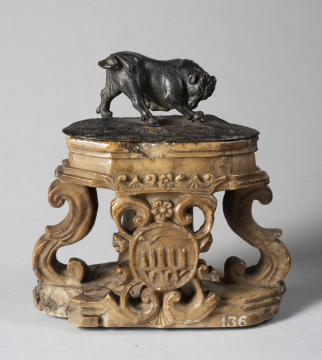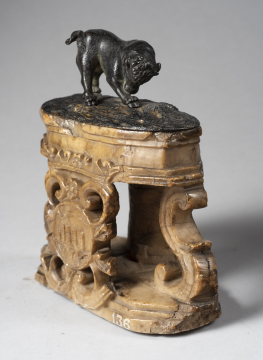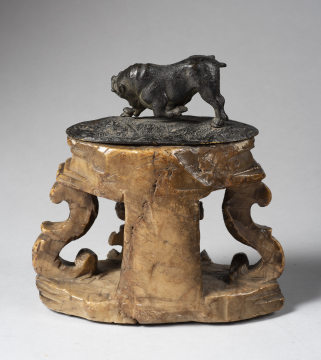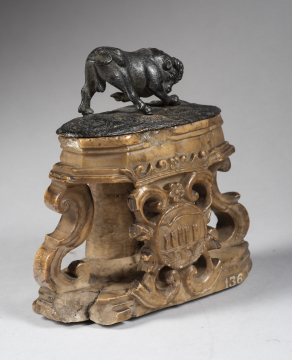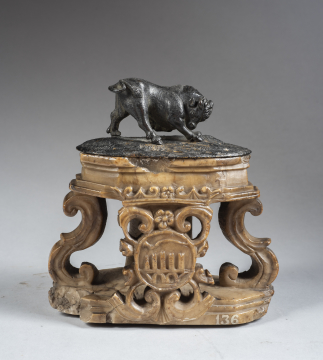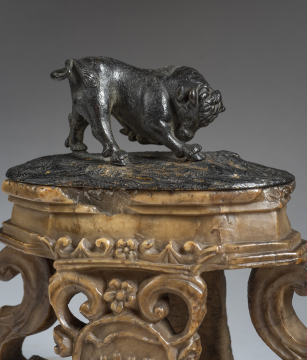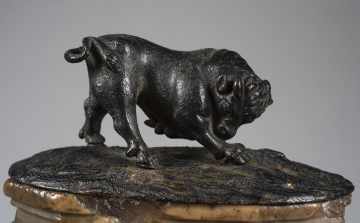Explore Collections


You are here:
CollectionsOnline
/
Small bull mounted on a carved alabaster base made in Trapani in Sicily and bearing the arms of the city
Browse
SM S136. ©Sir John Soane's Museum, London. Photo: Art UK
Small bull mounted on a carved alabaster base made in Trapani in Sicily and bearing the arms of the city
c.1650-1750
Trapani, manufactured
Base
Base
Bronze on carved alabaster base
Height: 18cm
Width: 18cm
Depth: 9.5cm
Width: 18cm
Depth: 9.5cm
Museum number: S136
Not on display
Curatorial note
This is a composite piece, with the small bronze figure of a bull mounted onto a gilt-bronze plate and then onto an alabaster base.
The lively bull is shown standing on three legs in the act of pawing the ground with its head bent and its tail curved, in a manner that is almost playful, although in fact it is probably either intended to show the animal about to charge an adversary, or may possibly be a representation of a 'bull breaking the egg'. The bronze has been de-patinated and then re-patinated, which accounts for the rather dull black surface. The gilt-bronze base plate on which the bull stands is later but has the same black surface, with the gilding now showing through.
The statuette of the bull was purchased at the sale of the effects of the painter Richard Cosway in 1821 and described in the sale catalogue as a 'bull breaking the egg', though no egg is present. Soane owned Recherches sur l'origine, l'esprit et les progrès des arts de la Grèce; sur leur connexion avec les arts et la religion des plus anciens peuples connus; sur les monuments antique de l'Inde, de la Perse, due reste de l'Asie, de l'Europe et de l'Egypte, (3 vols, London, 1785), by the theorist Pierre-François Hugues (1719-1805), self-styled Baron d'Hancarville. D'Hancarville argued that the earliest representation of the creation was the image of a bull striking a massive egg with its horns. Soane, who habitually made marginal comments in his books, noted that 'God the creator fructified the egg of Chaos, the egg carried in procession at the sacred mysteries'. Soane also annotated plate VIIIA in the book which showed the bull breaking the egg.
The statuette of the bull was thought to be an antique bronze when Sir John Soane bought it, and it has ever since usually been thought to date from the Roman period. It is in fact a model produced in the seventeenth century, probably in Italy, since three of the other four known versions are in Italian public collections. The fourth is at Anglesey Abbey, Cambridge (National Trust, Inv. NT 515062). It is typical of the sort of small-scale animal subjects produced by the Italo-Flemish sculptor Giambologna (1529-1608) and by his followers and imitators in Florence and elsewhere.
The alabaster base on the other hand was made in Trapani in Sicily, in the 17th or early 18th century. It was made as the base for a small reduction, also in alabaster, of the Madonna of Trapani, a famous marble statue of the Virgin and Child made in the fourteenth century in a Pisan workshop. The statue, now displayed in the Basilica-Sanctuary of Maria Santissima Annunziata, is said to have been given to the city of Trapani by a Pisan merchant who, whilst returning from the Levant, found shelter there from a violent storm. The shrine of the Madonna of Trapani became one of the most famous in Europe, a destination for pilgrims from throughout the Mediterranean and beyond. Small reductions of the Madonna in alabaster, coral and ivory began to be made from the fifteenth century and by the late seventeenth century were being produced in their thousands in around forty workshops, mainly for sale to pilgrims. Many had on their base the arms of the city of Trapani, with five towers upon a three-arched bridge below a sickle, surmounted by a crown. The city of Trapani is located on a sickle-shaped peninsula, according to legend created when the Goddess Demeter dropped her sickle whilst searching for her daughter Persephone. The ancient Greek name for Trapani, Drepanon, in fact means 'sickle' in Greek.
We are grateful to Dr Jeremy Warren for his help with this catalogue entry 2021
The lively bull is shown standing on three legs in the act of pawing the ground with its head bent and its tail curved, in a manner that is almost playful, although in fact it is probably either intended to show the animal about to charge an adversary, or may possibly be a representation of a 'bull breaking the egg'. The bronze has been de-patinated and then re-patinated, which accounts for the rather dull black surface. The gilt-bronze base plate on which the bull stands is later but has the same black surface, with the gilding now showing through.
The statuette of the bull was purchased at the sale of the effects of the painter Richard Cosway in 1821 and described in the sale catalogue as a 'bull breaking the egg', though no egg is present. Soane owned Recherches sur l'origine, l'esprit et les progrès des arts de la Grèce; sur leur connexion avec les arts et la religion des plus anciens peuples connus; sur les monuments antique de l'Inde, de la Perse, due reste de l'Asie, de l'Europe et de l'Egypte, (3 vols, London, 1785), by the theorist Pierre-François Hugues (1719-1805), self-styled Baron d'Hancarville. D'Hancarville argued that the earliest representation of the creation was the image of a bull striking a massive egg with its horns. Soane, who habitually made marginal comments in his books, noted that 'God the creator fructified the egg of Chaos, the egg carried in procession at the sacred mysteries'. Soane also annotated plate VIIIA in the book which showed the bull breaking the egg.
The statuette of the bull was thought to be an antique bronze when Sir John Soane bought it, and it has ever since usually been thought to date from the Roman period. It is in fact a model produced in the seventeenth century, probably in Italy, since three of the other four known versions are in Italian public collections. The fourth is at Anglesey Abbey, Cambridge (National Trust, Inv. NT 515062). It is typical of the sort of small-scale animal subjects produced by the Italo-Flemish sculptor Giambologna (1529-1608) and by his followers and imitators in Florence and elsewhere.
The alabaster base on the other hand was made in Trapani in Sicily, in the 17th or early 18th century. It was made as the base for a small reduction, also in alabaster, of the Madonna of Trapani, a famous marble statue of the Virgin and Child made in the fourteenth century in a Pisan workshop. The statue, now displayed in the Basilica-Sanctuary of Maria Santissima Annunziata, is said to have been given to the city of Trapani by a Pisan merchant who, whilst returning from the Levant, found shelter there from a violent storm. The shrine of the Madonna of Trapani became one of the most famous in Europe, a destination for pilgrims from throughout the Mediterranean and beyond. Small reductions of the Madonna in alabaster, coral and ivory began to be made from the fifteenth century and by the late seventeenth century were being produced in their thousands in around forty workshops, mainly for sale to pilgrims. Many had on their base the arms of the city of Trapani, with five towers upon a three-arched bridge below a sickle, surmounted by a crown. The city of Trapani is located on a sickle-shaped peninsula, according to legend created when the Goddess Demeter dropped her sickle whilst searching for her daughter Persephone. The ancient Greek name for Trapani, Drepanon, in fact means 'sickle' in Greek.
We are grateful to Dr Jeremy Warren for his help with this catalogue entry 2021
Richard Cosway Sale, held by Mr. Stanley, 22-24 May 1821, second day, bronzes, Lot 67 ‘The bull breaking the egg, on a marble stand’, purchased for £2.12.6 [see SM Archive Sale Catalogues 1/33, a marked copy of the catalogue with receipt].
Literature
David Watkin, Sir John Soane, Enlightenment Thought and the Royal Academy Lectures, 1996, pp.256-262.
Exhibition history
Richard and Maria Cosway: Regency Artists of Taste and Fashion, Scottish National Portrait Gallery, Edinburgh, 11 August - 29 October 1995; National Portrait Gallery, London, 17 November 1995 - 18 February 1996
Associated items
m632, another similar
Soane collections online is being continually updated. If you wish to find out more or if you have any further information about this object please contact us: worksofart@soane.org.uk
